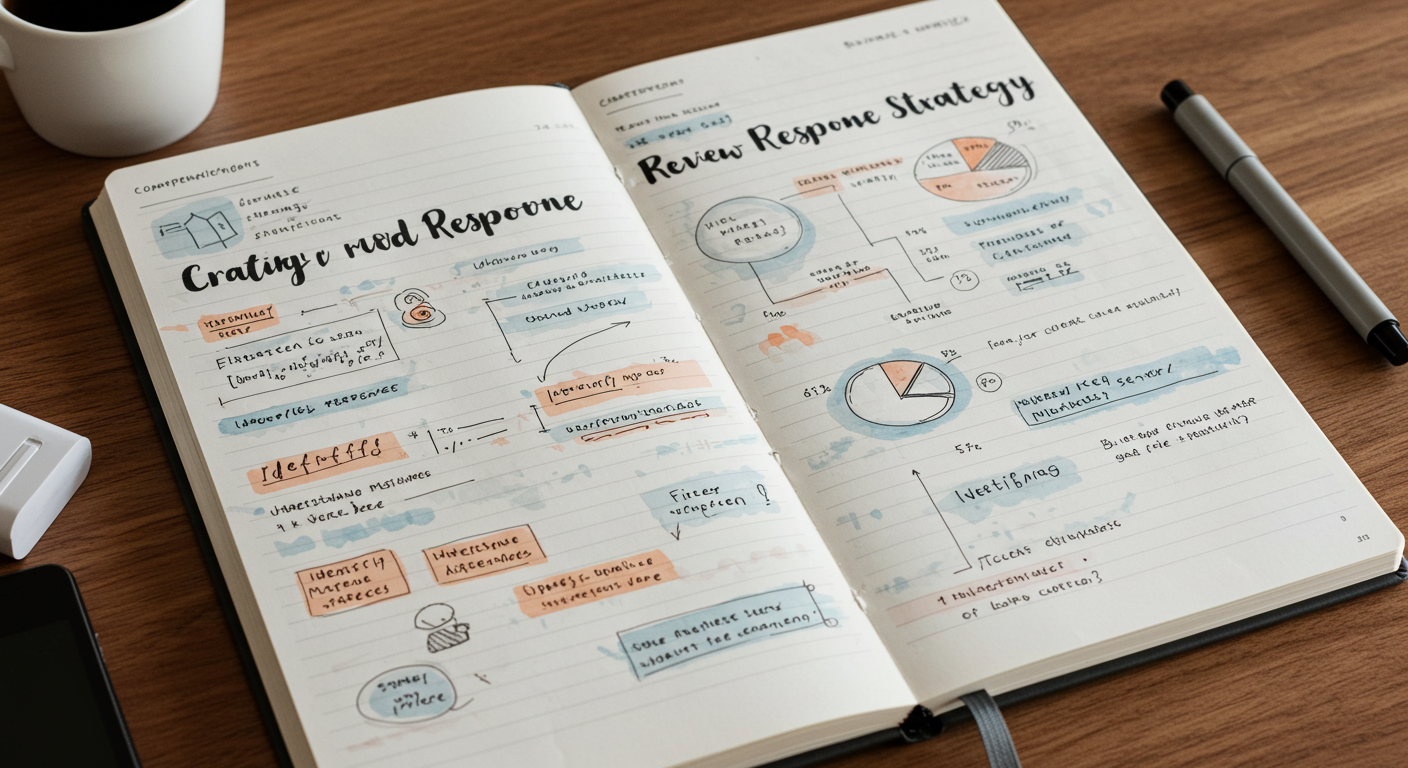We Manage Your Online Reviews Effectively
Steering through the world of online reviews can feel like a delicate dance, but it doesn’t have to be overwhelming. You’ll find that managing your feedback effectively can make a significant difference in how customers perceive your brand. By responding promptly and thoughtfully to all reviews, you create a dialogue that fosters loyalty and trust. However, understanding the nuances of what makes an effective strategy can be challenging. So, what are the key elements that can elevate your approach and truly resonate with your audience?
Key Takeaways
- Utilize automated tools like GatherUp and ReviewTrackers for efficient monitoring and management of online reviews across platforms.
- Engage with customers promptly, aiming for responses within 24-48 hours to enhance satisfaction and brand credibility.
- Personalize responses by thanking reviewers and addressing their specific comments to foster a deeper connection.
- Analyze negative feedback to identify patterns and systemic issues, driving continuous improvement in services or products.
- Encourage positive reviews through streamlined processes and incentives, boosting brand visibility and reputation.
Importance of Online Review Management
https://www.youtube.com/watch?v=z-HGfqJdo0w
In today’s digital landscape, the importance of online review management can’t be overstated. You mightn’t realize it, but effective management of reviews can greatly enhance your brand reputation and foster customer trust.
When potential customers see authentic reviews, they’re more likely to choose your business over competitors. In fact, up to 93% of buyers rely on online feedback to make purchasing decisions. Positive reviews can enhance brand credibility and trust, making it even more essential to manage your online presence effectively. Trust factors like reviews serve as social proof, further influencing potential customers’ choices.
Managing reviews proactively helps you identify areas for improvement, allowing you to address customer pain points before they escalate. By engaging actively with customers, whether through positive or negative feedback, you create a sense of belonging that builds loyalty.
Plus, responding promptly enhances customer satisfaction, which can lead to higher conversion rates.
Key Review Platforms to Consider
Steering through the world of online reviews can feel overwhelming, but identifying the right platforms to manage your feedback is crucial for your business’s success.
Start with Google My Business—it’s essential for local visibility and directly influences your SEO. Trustpilot and Amazon are key players for e-commerce, offering a global reach and a focus on review authenticity, making them indispensable for product feedback. 66% of US customers believe online reviews influence buying decisions, highlighting the importance of leveraging these platforms effectively. Additionally, 68% of consumers are likely to leave reviews when prompted, underscoring the necessity of actively engaging with customers.
For local businesses, Yelp and TripAdvisor shine by showcasing customer experiences, while Foursquare adds a social media twist to on-site reviews.
If you’re in the service industry, consider Angi for detailed home service reviews. You can also turn to Capterra and G2 for software and product evaluations, enabling effective platform comparisons that can guide your decisions.
Don’t overlook the Better Business Bureau (BBB) for building trust across various industries or Glassdoor for managing your employer brand through employee insights.
Each of these platforms serves a unique purpose, and by strategically utilizing them, you can cultivate a strong online presence and foster a sense of community around your brand.
Crafting a Review Response Strategy

Crafting an effective review response strategy is essential for building strong customer relationships. You need to respond promptly and personally to all reviews, especially the negative ones, to show that you value feedback and are committed to improvement. Engaging with customers through timely responses not only enhances brand credibility but also fosters a sense of community and connection. Additionally, consistent response strategy reflects your commitment to excellence and can significantly improve your overall brand perception.
Timely Response Importance
Responding to reviews in a timely manner is essential for your business’s success. When you engage quickly, you not only boost customer satisfaction but also enhance your brand reputation. Timely feedback shows your customers that their opinions matter, fostering trust and loyalty. Additionally, consumers are more likely to visit businesses that respond to negative reviews, which highlights the importance of addressing feedback promptly.
It’s vital to aim for a response window of 24-48 hours; this can greatly improve your local Google rankings and visibility. Regular responses to reviews can also signal credibility and trustworthiness to potential customers.
Implementing effective response strategies is key. Assign team members to manage reviews and create a clear policy that outlines response procedures. Use automation tools to streamline your process, ensuring you don’t miss valuable opportunities to connect with customers.
Immediate responses to positive reviews can strengthen relationships, while addressing negative feedback promptly can convert detractors into advocates.
Remember, delayed responses can amplify negative experiences, leading to lost business.
Regularly monitor reviews, maintain consistency in your response times, and set clear expectations for more complex issues. By prioritizing timely responses, you increase customer engagement and encourage further feedback, ultimately driving growth for your business.
Your commitment to timely interactions reflects positively on your brand and cultivates a loyal community around it.
Personalization Techniques
Engaging with customers through personalized review responses can greatly enhance your brand’s connection with its audience. By implementing a personalized review response strategy, you not only show appreciation but also foster a sense of belonging.
Start every response with a heartfelt thank you, acknowledging the reviewer’s specific comments. Address them by name to make it feel more intimate and tailored.
Professionalism and consistency are key. Using the same brand voice across all responses reinforces your identity. Recognize the core sentiment behind each review—whether it’s a compliment or a complaint—before crafting your message. This approach is especially important because 75% of buyers trust online reviews as much as personal recommendations, highlighting the significance of how you respond. Additionally, responding to reviews can enhance customer trust, further solidifying your brand’s reputation in a competitive market.
If your business spans multiple locations, mention the specific town or city to add a local touch. This small detail can deepen the customer connection.
Encourage further engagement by inviting reviewers to follow up or share more feedback. Demonstrating genuine interest in their experience not only enhances personalization benefits but also shows you care.
Regularly review and update your strategy to align with changing customer expectations, ensuring that each response resonates effectively. By focusing on personalization, you’ll build stronger relationships and a loyal customer base.
Managing Negative Feedback

Negative feedback can feel like a storm cloud hovering over your business, but it also presents a unique opportunity for growth and improvement. By crafting a strategic review response plan, you can turn that cloud into a silver lining.
To effectively manage negative feedback, consider the following approach:
| Step | Action | Outcome |
|---|---|---|
| Acknowledge Concerns | Respond promptly, showing customer empathy. | Builds trust and rapport. |
| Use the Sandwich Approach | Start with something positive, address the issue, and end on a positive note. | Balances emotions and encourages dialogue. |
| Create Feedback Loops | Implement changes based on feedback and keep customers informed. | Shows commitment to improvement. |
Embrace a growth mindset by actively listening, reflecting on the feedback, and setting measurable goals. This approach not only enhances your service but also fosters a sense of belonging among your customers. By maintaining professionalism and consistency, you transform negative reviews into powerful tools for improvement, ensuring your brand stays connected and responsive.
Customer Engagement Techniques
When it comes to managing online reviews, implementing effective customer engagement techniques is vital for building lasting relationships with your audience.
Start by encouraging online reviews. Streamline the review process, personalize requests, and provide clear instructions on how to leave feedback. Using QR codes on products can make it even easier for customers to share their thoughts, while incentives like discounts can motivate them to participate actively.
Leverage email campaigns to nurture these connections. Send follow-up emails thanking customers for their purchase, and include clear calls to action that invite them to leave feedback.
Segment your email lists to tailor your messages, ensuring customers feel valued and understood.
Engaging with customer reviews is significant too. Acknowledge all feedback, responding to both positive and negative reviews professionally.
Highlight positive experiences on social media to inspire others, and consider creating content around testimonials that showcase your brand’s impact.
Effective Review Management Tools
Effective review management tools are vital for any business aiming to harness the power of customer feedback. By utilizing features like review automation and monitoring capabilities, you can streamline the process of requesting and managing reviews across various platforms. This helps guarantee you never miss valuable customer insights.
Tools such as GatherUp and ReviewTrackers excel in providing review analytics, allowing you to track your online reputation effectively. With a single dashboard, you can monitor customer sentiments and respond promptly.
Dashclicks offers flexibility, enabling you to customize messaging while Grade.us provides extensive integrations and a white-label option for those seeking a tailored approach.
Moreover, platforms like Reviews.io not only give you a thorough view of your reviews but also help you analyze competitors’ feedback, granting you a competitive edge. By automating review requests and responses, you save time and enhance your operational efficiency.
Choosing the right tool for your business size and feature needs is essential. Look for options that offer transparent pricing and robust support to help you navigate the world of online reviews.
Embrace these effective tools to build a credible online presence and foster a sense of belonging among your customers.
Best Practices for Requesting Reviews

Harnessing the insights gained from effective review management tools can greatly enhance your approach to requesting reviews. Start by considering your request timing; reach out soon after a customer’s experience, while it’s still fresh in their mind. This connection to their recent transaction can considerably impact their willingness to share feedback.
Be mindful of their mood, and follow up with gentle reminders if they’ve shown intent to leave a review.
Personalization is key. Use the customer’s name and tailor your request to reflect their unique experience, expressing genuine gratitude for their support. Make sure your communication is polite and non-intrusive, avoiding any aggressive tones.
Utilizing various review channels can maximize your outreach effectiveness. Send requests through email, text messages, or even phone calls. Incorporate review prompts in your emails with clear subject lines and concise messages. Automated systems can streamline this process, allowing you to send requests at ideal times.
Finally, craft your review request messages to be concise and easy to follow. Include direct links to your review profiles, making it easy for customers to share their thoughts. These best practices will help foster a strong sense of community and belonging among your customers.
Monitoring and Analyzing Reviews
Monitoring and analyzing reviews is essential for businesses aiming to enhance their reputation and customer satisfaction. By effectively tracking reviews, you can uncover insights that drive improvement and foster community engagement.
Here are three key aspects to focus on:
Review Volume: Keep tabs on the number of reviews over time to evaluate your review generation strategies.
Review Sentiment: Categorize reviews as positive, negative, or neutral to identify trends that impact your reputation.
Star Ratings: Monitor average star ratings across different platforms for a thorough view of customer perceptions.
Utilizing review monitoring software can streamline this process. With centralized inboxes, you’ll have a clear overview of all reviews in one place.
Automated alerts guarantee you’re promptly notified of new feedback, allowing you to act swiftly. Sentiment metrics help you understand the emotional tone behind each review, prioritizing your responses effectively.
Handling Negative Reviews Effectively

When you encounter negative reviews, it’s essential to acknowledge and validate the reviewer’s concerns to show you care.
Offering clear solutions and assistance not only addresses the issue but also demonstrates your commitment to improvement.
Maintaining a professional tone throughout your response will help build trust and encourage a positive dialogue with your customers.
Acknowledge and Validate Concerns
How can you effectively handle negative reviews to turn a dissatisfied customer into a loyal advocate? Acknowledging and validating concerns is key. Here’s how you can make a difference:
Timely Acknowledgment: Respond promptly to show your commitment to customer satisfaction. Acknowledge their concerns and apologize for any inconvenience, referencing specific issues in your response.
Empathetic Response: Show genuine empathy without being defensive. Sincerely express regret for their bad experience, recognizing their disappointment. This builds trust and shows you value their perspective.
Constructive Use of Feedback: Analyze negative reviews to spot recurring themes. Use this feedback to enhance the customer experience and communicate improvements, demonstrating your dedication to continuous improvement.
Offer Solutions and Assistance
After acknowledging and validating customer concerns, the next step is to offer solutions and assistance that demonstrate your commitment to resolving issues. This isn’t just about fixing problems; it’s about showing you care. Engage in solution brainstorming with your team and provide clear, actionable steps.
Here’s a simple framework to help you:
| Strategy | Action | Outcome |
|---|---|---|
| Clear Communication | Offer concrete solutions, like refunds or replacements. | Customers feel valued and heard. |
| Proactive Engagement | Respond promptly to feedback and invite ongoing dialogue. | Builds trust and transparency. |
| Resolution Process | Take complex issues offline for personalized support. | Enhances customer satisfaction. |
| Continuous Improvement | Use feedback to identify root causes and implement changes. | Creates a better customer experience. |
Maintain Professional Tone

Handling negative reviews effectively requires maintaining a professional tone throughout your response. When you approach these situations with grace, you not only address concerns but also strengthen your brand’s reputation.
Here are three essential strategies for crafting your response:
Respond Promptly: Aim to reply within 24-48 hours. This shows you care and are proactive.
Acknowledge and Validate: Directly recognize the reviewer’s specific concerns and validate their feelings.
Maintain Professional Language: Use respectful communication, avoiding defensiveness or argumentative tones.
By following these steps, you create a foundation for effective dialogue. Always keep your tone calm, and guarantee your feedback is concise and clear.
Sincerely apologize for any shortcomings, and offer solutions that demonstrate your commitment to improvement. Remember, your response is public; it reflects your brand’s values and helps build trust with potential customers.
In every interaction, focus on fostering a sense of belonging and understanding. By handling negative reviews with professionalism, you turn challenges into opportunities for growth and connection.
Leveraging Reviews for Business Growth
Leveraging online reviews can dramatically transform your business growth strategy. By enhancing your visibility on platforms like Google and social media, positive reviews not only improve your search engine optimization (SEO) but also establish your brand reputation.
When potential customers see glowing testimonials, they’re more likely to trust your business, which fosters customer loyalty.
Think about it: 72% of consumers trust local businesses more after reading positive reviews. This social proof is vital in setting you apart from competitors. Displaying reviews prominently on your website and social media can elevate engagement and encourage more purchases.
In fact, customers often feel reassured about their buying decisions when they see high ratings, paving the way for increased sales and even allowing you to command higher prices.
Moreover, reviews provide valuable feedback that can guide your continuous improvement efforts. By responding to both positive and negative feedback, you show that you care about your customers’ experiences, which strengthens your brand reputation.
With a proactive approach to managing reviews, you can create a thriving community around your brand, driving sustained growth and engagement.
Conclusion
Ultimately, managing your online reviews isn’t just important; it’s essential for your brand’s success. Did you know that 93% of consumers read online reviews before making a purchase? By actively engaging with feedback and implementing effective strategies, you can build trust and loyalty among your customers. Embrace the power of reviews to not only enhance your reputation but also drive growth. Start transforming your review management today, and watch your brand thrive!
